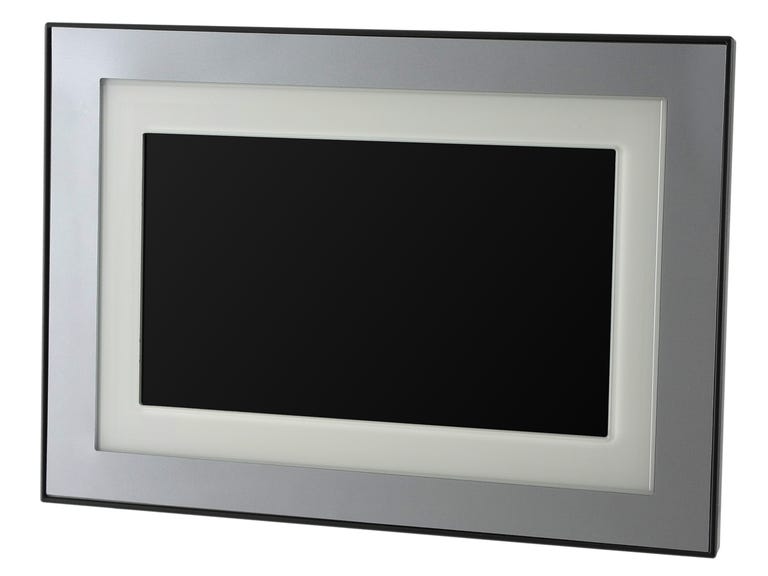 Why You Can Trust CNET
Why You Can Trust CNET Kodak EasyShare M820 Digital Frame review: Kodak EasyShare M820 Digital Frame
Kodak EasyShare M820 Digital Frame
Kodak offers a number of digital photo frames, including models that feature built-in wireless connectivity and even cutting-edge OLED display technology. However, its 8-inch EasyShare M820, available for less than $100, is an attractive option for consumers hoping to balance affordability with some advanced features in a reasonably sized frame.
The Good
The Bad
The Bottom Line
Some digital photo frames have real wood or metal finishes, but this is strictly a plastic affair. With its simple, slim black border, the frame looks elegant enough from afar and comes with two stick-on decorative mattes (one is red, the other silver) that allow you to customize the frame's look. The kickstand on the back swivels, giving you the option of locking the frame into horizontal or vertical orientation. On the back of the frame there are keyhole slots for mounting the frame to a wall with screws, along with a threaded tripod mount if you want to prop it up with a tripod.
In terms of features, the M820 is a step up from the basic package found in the entry-level P820 and P720--but you don't get the wireless connectivity found in Kodak's W-series photo frames, which include the W820 and W1020. The main upgrade here over the P series is support for video and MP3 playback (you can play music in the background of slideshows) and some built-in memory. There are two small speakers built into the back of the frame.
The M820 comes with 128MB of internal memory. That 128MB allows you to store about 1,000 images resized to the frame's 800x480 resolution; the images will automatically resize when you copy them to the frame if you select that option from the settings menu. But if you want to show off more photos, the frame accepts all memory cards, including CompactFlash, MemoryStick, SD/SDHC, and xD-Picture cards. There's also a full-size USB connector for plugging in thumbdrives or your camera and a mini USB to connect to a computer for drag-and-drop uploading.
This frame, like several other new frames, uses a Touch Border interface; you touch the bezel to access menus and settings. With this frame, the various touch points along the bottom and right side of the frame light up when you touch the bezel. You have to touch the border next to the icons that appear on the screen. For those used to dealing with a touch-screen display, this won't seem intuitive initially, but once you get used to it, the system works pretty well. We've seen some comments about the Touch Border not being senior-friendly, but anybody who reads the instructions should be able to get the hang of it fairly quickly. It is worth noting that compared to the basic P-series frame this model is more complicated to use simply because it has more features--and therefore more settings.
More standard features such as slideshow transitions and the aforementioned automatic image resizing are present and accounted for, and this model, like Kodak's step-up wireless frames, plays back most videos (MOV, AVI, MPEG-1, and MPEG-4) shot with popular digital still cameras. However, the frame will not display video from Flip Video cameras.
It's been a little while since we tested Kodak's higher-end W-series frames, but this model didn't appear to have the same zippiness as the W1020, for example. There was more lag in displaying thumbnail images from memory cards and overall the frame just didn't feel quite as responsive. Video doesn't play very well at all, with audio as well as slideshow background music prone to stuttering.
As for image quality, it's decent, not great, but a big step up from the lower resolution P720 7-inch frame. At 800x480, the image may not be razor sharp and you'll see some slight stair-stepping on curved edges and diagonal lines, like on leaves. The colors look pretty natural, and though blacks may not be terribly deep, there's enough dynamic range in the midtones to render sufficient detail in shadows. As with most LCD frames, when positioned vertically there's little to no off-axis viewing on one side; the photo inverts or disappears when viewed at more than 25 degrees or so from center. While the sound quality from the tinny internal speakers isn't great--you can play MP3 files as background music for your slide shows--it's passable.
In the end, as we said, what makes this frame an attractive option is the combination of decent image quality and a respectable feature set for less than $100. For someone who doesn't want to spend $50 or so more for built-in wireless connectivity (which certainly is an appealing feature), the M820 is a solid if unspectacular choice.


